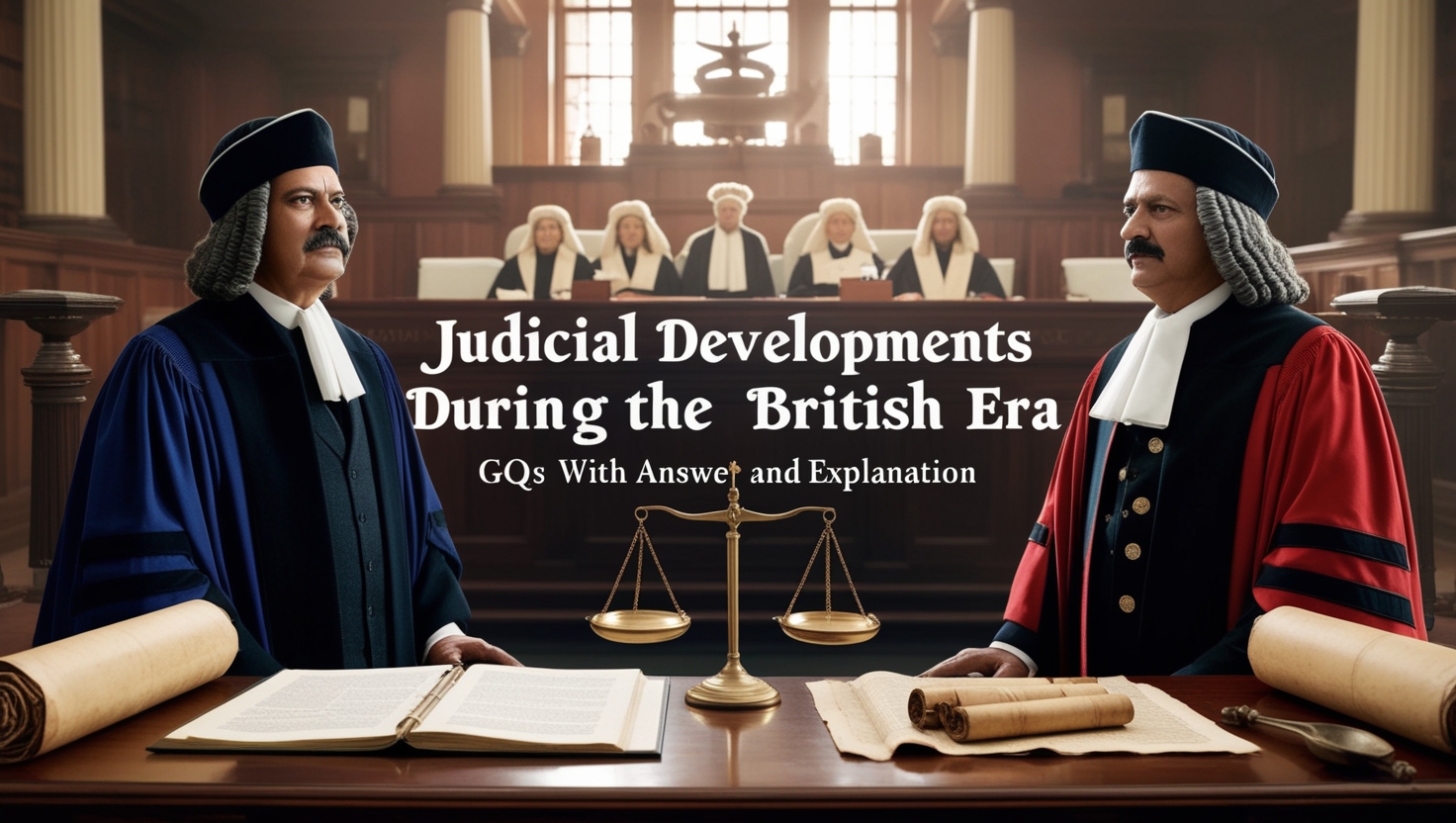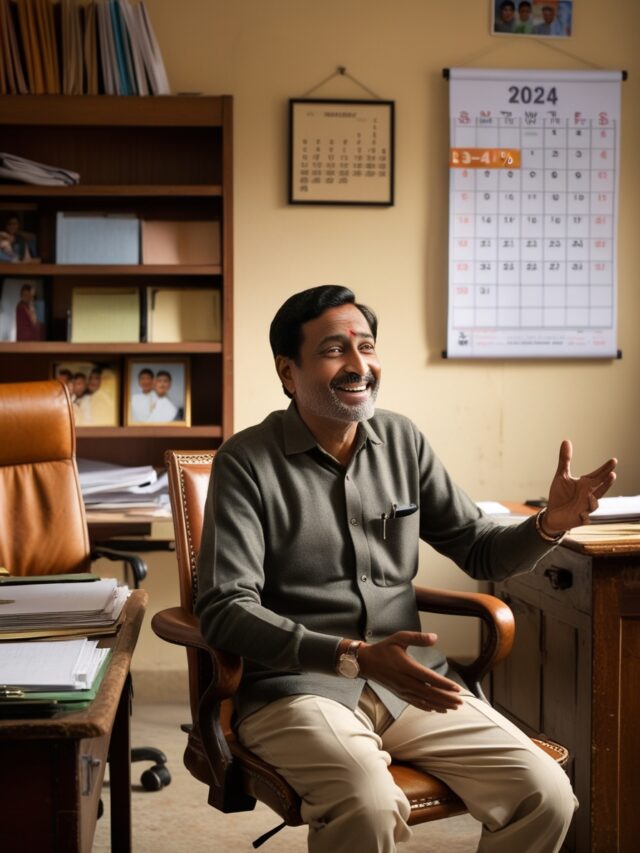
1. In which year was the first provision enabling the East India Company to exercise judicial powers on Indian soil made by the British?
- 1661
- 1726
- 1733
- 1757
Show Answer
Answer: 1661
The Charter of Charles II in 1661 marked a significant development in the history of the British East India Company. This charter granted the company judicial powers on Indian soil, enabling it to administer justice. Prior to this, under the Charter of 1600, the company lacked authority to make decisions in matters like murder or unrelated issues involving non-members of the company.
2. During the 17th century, which region of India had active Choultry Courts that imparted justice according to long-established traditions?
- Bengal
- Madras
- Carnatic
- Gujarat
Show Answer
Answer: Madras
Between 1639 and 1661, Madraspatanam had two separate entities administering justice. The English agent and council held judicial authority for English residents, while indigenous people fell under the jurisdiction of the Choultry court. The Choultry court, presided over by an Adigar, a local village headman, adjudicated cases for natives based on traditional customs and usages.
3. Where did the first trial by jury in the history of India take place?
- Calcutta
- Bombay
- Madras
- Surat
Show Answer
Answer: Madras
The first trial by jury in India occurred in Madras in the Agent’s court. This historic trial involved a British woman named Mrs. Ascentia Zawes, accused of murdering her Indian slave. She was found “not guilty.”
4. In which year was the admiralty court established in Madras?
- 1675
- 1683
- 1689
- 1697
Show Answer
Answer: 1683
King Charles II issued a charter on August 9, 1683, granting the East India Company authority to establish courts. As a result, the admiralty court was established on July 10, 1686. This court, presided over by a qualified lawyer serving as the judge-advocate, had a broader jurisdiction and handled various types of cases, including civil, criminal, maritime, and mercantile matters.
5. In the 1670s, under the watch of Gerald Aungier, two judicial systems were established in which town?
- Calcutta
- Madras
- Bombay
- Surat
Show Answer
Answer: Bombay
Gerald Aungier, the Second Governor of Bombay, played a pivotal role in instituting a judicial system in Bombay. Two judicial systems were established there. The first system was established in 1670, consisting of the Court of Customs Officer and the Court of Deputy Governor-in-Council, designed to facilitate governance.
6. When was Bombay Court established?
- 1827
- 1852
- 1862
- 1876
Show Answer
Answer: 1862
The Court of Judicature was founded in Bombay on March 25, 1718, replacing the earlier judicial system. This court included an English chief justice, five English judges, and four Indian judges representing the main communities in Bombay: Hindus, Muslims, Portuguese, and Parsis. The Indian judges had a subsidiary role, providing insight into local matters and customs.
7. The Charter Act of 1726 provided for the establishment of a Corporation in which of these places?
- Bombay and Surat
- Bombay and Calcutta
- Calcutta and Madras
- Calcutta and Surat
Show Answer
Answer: Bombay and Calcutta
The Charter of 1726 led to the establishment of corporations in Bombay and Calcutta, similar to the existing one in Madras. These corporations comprised a Mayor and nine Aldermen, collectively forming the ‘Mayor’s Court,’ responsible for resolving civil cases within the respective Presidency towns and their subordinate factories.
8. The Charter of 1726 empowered which of the following with legislative powers to make bye-laws, ordinances, and rules?
- Mayor
- Sheriff
- Governor and Council
- Deputy Governor and Council
Show Answer
Answer: Governor and Council
The Charter of 1726 granted the Governor and Council of each Presidency town the power to make bye-laws, rules, and ordinances for governing the Corporations and the inhabitants of the Presidencies.
9. In which charter was the provision to establish the Court of Requests made?
- Charter of 1726
- Charter of 1733
- Charter of 1753
- Charter of 1780
Show Answer
Answer: Charter of 1753
The Charter of 1753 was an updated version of the Charter of 1726. It established a hierarchy of four courts for the administration of justice in the three Presidencies, including the Court of Requests for petty civil cases and the Mayor’s Court for more significant cases.
10. In which year was the Supreme Court of Judicature established in Calcutta?
- 1757
- 1774
- 1778
- 1783
Show Answer
Answer: 1774
The Regulating Act of 1773 led to the creation of the Supreme Court of Judicature in Calcutta. It consisted of one Chief Justice and three Puisne Judges appointed by the British Crown to act at its pleasure. Sir Elijah Impey served as the first Chief Justice.
Q11: Under which of the following acts was a Special Court established in England to try any offences committed in India?
1. Regulating Act, 1773
2. Amending Act, 1781
3. Amending Act, 1786
4. Pitts India Act, 1784
Show Answer
Answer: 4
Explanation: Under Pitt’s India Act of 1784, a special court was formed to try offenses committed in India. It consisted of three judges, four peers, and six members of the House of Commons. While this act was in force until 1858, it underwent some amendments in 1786.
Q12: Under the Hastings Plan of 1772, the Mofussil Diwani Adalats were headed by whom?
1. Collector
2. Deputy Governor in Council
3. A member of Governor in Council
4. A local Indian judge
Show Answer
Answer: 1
Explanation: The Mofussil Diwani Adalats, established under the Hastings Plan of 1772, served as district-level civil courts, presided over by the Collector. These courts handled various civil cases, including property, inheritance, marriage, and contracts, with assistance from native law officers.
Q13: Where was the Sadar Diwani Adalat established under Warren Hastings Plan in 1772?
1. Calcutta
2. Bombay
3. Patna
4. Murshidabad
Show Answer
Answer: 1
Explanation: The Sadar Diwani Adalat, established under the same plan, exercised appellate jurisdiction over Mofussil Diwani Adalats for cases exceeding Rs. 500. It was composed of the Governor as its President and at least two Council members, aided by other officials.
Q14: Under the Warren Hastings Plan of 1772, the Mofussil Nijamat Adalat was established to handle:
1. Civil Cases at District Level
2. Criminal Cases at District Level
3. Civil Cases at Village Level
4. Criminal Cases at Village Level
Show Answer
Answer: 2
Explanation: The Mofussil Nijamat Adalat, also known as the Fauzdari Adalat, functioned as a criminal court in each district. It handled serious criminal offenses such as murder, robbery, and fraud, with assistance from legal officers like Kazi and Moulvies to interpret Islamic law. The Collector supervised the Fauzdari Adalat.
Q15: Who headed the Sadar Nizamat Adalat at Calcutta established under Warren Hastings’ Plan of 1772?
1. Nawab
2. Kazi
3. Chief Mufti
4. Daroga-i-Adalat
Show Answer
Answer: 4
Explanation: The Sadar Nizamat Adalat, established under Warren Hastings’ Plan of 1772, was a superior court in Calcutta with control over the Fauzdari Adalats. It was presided over by an Indian judge known as the Daroga-i-Adalat, supported by other religious and legal experts, assisting in matters of justice.
Q16: In which year was the Sadar Fouzdari Adalat shifted from Calcutta to Murshidabad?
1. 1774
2. 1775
3. 1778
4. 1780
Show Answer
Answer: 2
Explanation: The Sadar Nizamat Adalat was established in Calcutta in 1772. In 1775, it was moved to Murshidabad to avoid conflict with the Supreme Court. The Naib-Nazim Reza Khan was put in charge of the Sadar Nizamat Adalat in Murshidabad.
In 1772, Governor-General of Bengal Warren Hastings established two courts in each district: a criminal court (Faujdari Adalat) and a civil court (Diwani Adalat)
Q17: The Supreme Court of Judicature at Fort William was created under which of the following acts?
1. Charter of 1753
2. The Regulating Act 1773
3. Pitts India Act, 1784
4. Amending Act, 1781
Show Answer
Answer: 2
Explanation: The Supreme Court of Judicature at Fort William was created under The Regulating Act 1773. This Supreme Court consisted of one Chief Justice and three other regular judges or Puisne Judges. Sir Elijah Impey was the first Chief Justice of this Supreme Court.
Q18: Court Fees were abolished in which of the following plans/Acts?
1. Judicial Plan of 1787
2. Judicial Plan of 1790
3. Judicial Plan of 1793
4. Pitts India Act, 1784
Show Answer
Answer: 3
Explanation: Court fees, which were imposed in the Judicial Plan of 1787, were abolished by the Judicial Plan of 1793. The court fee was abolished to make justice more accessible to people, as litigation was costly due to travel expenses, heavy fees to Vakils (lawyers), and the Court-fee to be paid by litigants. Cornwallis desired to abolish the Court-fees so that justice may be available to all.
Q19: Which of the following were two rival sets of Judicial institutions in India before the enactment of the Indian High Courts Act, 1861?
1. High Courts and Supreme Courts
2. Revenue Courts and General Courts
3. Crown Courts and Company Courts
4. District Courts and High Courts
Show Answer
Answer: 3
Explanation: Prior to the passing of the Indian High Courts Act, 1861, there were two rival sets of judicial institutions in India, viz. Crown’s Courts and Company Courts. The Supreme Courts established in the Presidency towns of Calcutta, Madras, and Bombay were the courts of the British Crown, while the Adalats established in District/Mofussil areas were the courts of the East India Company.
Q20: Under which year was the Federal Court inaugurated in New Delhi?
1. 1935
2. 1937
3. 1939
4. 1940
Show Answer
Answer: 2
Explanation: The Federal Court was inaugurated in New Delhi on 1st October 1937. It was established under the Government of India Act, 1935, which introduced a federal form of government in India.
Q21: In which year was the Privy Council created to hear appeals from the courts in British Colonies?
1. 1726
2. 1768
3. 1802
4. 1833
Show Answer
Answer: 4
Explanation: The Privy Council, which acted as an appellate body to hear appeals from British colonies, was created on 14th August 1833 by the Act of the Parliament. Prior to this, the Judicial Committee of the Privy Council had been functioning since 1726, mainly through committees and sub-committees.
Q22: Which of the following was the highest court of appeal before the independence of India?
1. Viceroy in Council
2. King-in-Council
3. Privy Council
4. Federal Court
Show Answer
Answer: 3
Explanation: The Judicial Committee of the Privy Council in London was the highest court of appeal before the independence of India. It heard appeals from the Federal Court of India and was established on 13 August 1833.
Q23: Which of the following bills was introduced to grant power to Indian district magistrates to try European criminals?
1. Ilbert Bill
2. Dundas Bill
3. Macaulay Bill
4. Amending Bill 1781
Show Answer
Answer: 1
Explanation: The Ilbert Bill was introduced in 1883 by Viceroy Ripon, who aimed to abolish racial prejudice from the Indian Penal Code. The bill proposed an amendment to existing laws in the country, allowing Indian judges and magistrates the jurisdiction to try British offenders in criminal cases at the District level.







